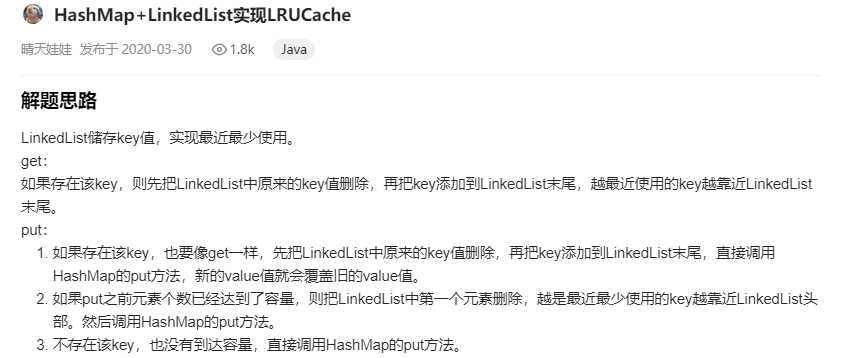设计和构建一个“最近最少使用”缓存,该缓存会删除最近最少使用的项目。缓存应该从键映射到值(允许你插入和检索特定键对应的值),并在初始化时指定最大容量。当缓存被填满时,它应该删除最近最少使用的项目。
它应该支持以下操作: 获取数据 get 和 写入数据 put 。
获取数据 get(key) - 如果密钥 (key) 存在于缓存中,则获取密钥的值(总是正数),否则返回 -1。
写入数据 put(key, value) - 如果密钥不存在,则写入其数据值。当缓存容量达到上限时,它应该在写入新数据之前删除最近最少使用的数据值,从而为新的数据值留出空间。
示例:
LRUCache cache = new LRUCache( 2 /* 缓存容量 */ );
cache.put(1, 1);
cache.put(2, 2);
cache.get(1); // 返回 1
cache.put(3, 3); // 该操作会使得密钥 2 作废
cache.get(2); // 返回 -1 (未找到)
cache.put(4, 4); // 该操作会使得密钥 1 作废
cache.get(1); // 返回 -1 (未找到)
cache.get(3); // 返回 3
cache.get(4); // 返回 4
来源:力扣(LeetCode)
链接:https://leetcode-cn.com/problems/lru-cache-lcci

解题:
import java.util.HashMap; import java.util.LinkedList; class LRUCache {
private int capacity; private HashMap<Integer, Integer> map; private LinkedList<Integer> list; public LRUCache(int capacity) { this.capacity = capacity; map = new HashMap<>(); list = new LinkedList<>(); } public int get(int key) { if (map.containsKey(key)) { list.remove(key); list.addLast(key); return map.get(key); } return -1; } public void put(int key, int value) { // 1 如果包含这个key if (map.containsKey(key)) { list.remove(key); list.addLast(key); map.put(key, value); return; } //2 不包含这个key if (list.size() == capacity) { // 移除 Integer integer = list.removeFirst(); map.remove(integer); list.addLast(key); map.put(key, value); } else { list.addLast(key); map.put(key, value); } } } /** * Your LRUCache object will be instantiated and called as such: * LRUCache obj = new LRUCache(capacity); * int param_1 = obj.get(key); * obj.put(key,value); */